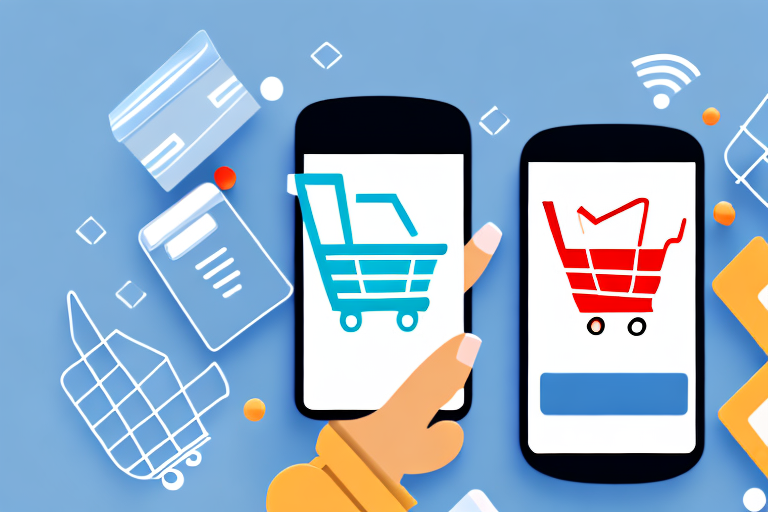Creating Mobile Apps for E-Commerce: A Comprehensive Guide
Today's consumers are constantly on the go, and they want access to all the products and services they need right at their fingertips. That's why mobile apps have become a must-have for businesses looking to stay competitive in the e-commerce market. In this comprehensive guide, we'll explore the ins and outs of creating a mobile app for your e-commerce store and show you how to design an app that will engage and delight your customers.
Why Mobile Apps are Essential for E-Commerce Businesses
In recent years, mobile usage has exploded. As of 2023, over 54% of global web traffic comes from mobile devices (Statista). People are now spending more time browsing the internet on their smartphones than on their computers. This trend has had a significant impact on the e-commerce industry, and businesses that fail to adapt risk falling behind their competitors.
Mobile apps offer a level of convenience and accessibility that websites simply can't match, allowing customers to make purchases and manage their accounts on the go. By creating a mobile app for your e-commerce store, you can tap into this growing market and reach customers wherever they are.
Moreover, mobile apps provide a personalized shopping experience for customers. By analyzing their browsing and purchase history, you can offer tailored recommendations and promotions, increasing the likelihood of repeat business. Additionally, mobile apps enable push notifications, which can be used to alert customers of sales, new products, and other promotions. This direct communication with customers can help build brand loyalty and keep your business top of mind.
Top Benefits of Developing a Mobile App for Your E-Commerce Store
Enhanced User Experience
Mobile apps offer a much faster and smoother shopping experience than mobile websites. Features such as quick navigation, easy product searches, and streamlined checkout processes make it easier for customers to browse products, add items to their cart, and complete purchases.
Personalization and Customer Engagement
- Personalized recommendations based on user behavior
- Targeted promotions and discounts
- Push notifications for timely updates and offers
These features not only enhance the shopping experience but also increase customer loyalty and boost sales.
Valuable Customer Insights
Developing a mobile app allows you to gather valuable data about your customers. By tracking their behavior within the app, you can gain insights into their preferences, shopping habits, and pain points. This information can then be used to improve your product offerings, marketing strategies, and overall customer experience.
According to a study by eMarketer, personalized marketing can lead to a 20% increase in sales. Leveraging such data effectively can give your brand a competitive edge.
Understanding the Basics of Mobile App Development for E-Commerce
Choosing the Right Platform
The first step in mobile app development is deciding whether to develop for iOS, Android, or both. Each platform has its own set of advantages and challenges:
- iOS: Higher user engagement rates and customers tend to spend more on apps.
- Android: Larger global market share and more flexibility in customization.
Selecting the Appropriate Technology
Once you've chosen the platform, the next step is selecting the programming language and development framework. Common choices include:
- Swift: Primarily used for iOS app development.
- Kotlin: Often used for Android app development.
- React Native: Allows for cross-platform development, reducing time and costs.
Building Core Features
Key features to include in your e-commerce mobile app are:
- Product listings with detailed descriptions and images
- Shopping cart functionality
- Secure payment gateways
- User account management
- Search and filter options
Continuous Improvement
Mobile app development is an ongoing process. Regular updates, testing, and incorporation of customer feedback are essential to keep your app relevant and efficient. Additionally, consider app store optimization (ASO) and marketing strategies to enhance your app's visibility.
Choosing the Right Platform for Your E-Commerce Mobile App
Evaluating Platform Strengths
When choosing between iOS and Android, consider the following factors:
- Target Audience: Analyze the demographics of your customers to determine which platform they predominantly use.
- Budget: iOS development can be more expensive due to stricter guidelines and approval processes.
- Development Time: Android offers more flexibility but may require extensive testing across various devices and OS versions.
Feature Compatibility
Some features may be easier to implement on one platform over the other. For instance, if you're looking to incorporate advanced technologies like augmented reality (AR), iOS might be a better choice due to its robust AR frameworks.
Designing a User-Friendly Interface and Experience for Your Mobile App
Intuitive Navigation
A user-friendly interface ensures that customers can navigate your app effortlessly. Key design principles include:
- Simple and clear layout
- Consistent design elements
- Easy access to major sections like product categories, cart, and account settings
Accessibility Features
Ensure your app is accessible to all users, including those with disabilities. Incorporate features such as:
- Voice commands
- Screen readers
- High-contrast options for better visibility
Responsive Design
Your app should perform seamlessly across various device sizes and resolutions. A responsive design adapts to different screens, providing a consistent user experience.
Implementing Secure Payment Gateways in Your E-Commerce Mobile App
Choosing a Reliable Payment Provider
Security is paramount when handling transactions. Select a payment gateway that offers:
- Advanced encryption standards
- Fraud detection and prevention mechanisms
- Compliance with PCI DSS regulations
Popular options include PayPal, Stripe, and Square.
User Experience in Payment Processing
The payment process should be seamless and intuitive. Ensure that:
- Multiple payment options are available (credit cards, digital wallets, etc.)
- Instructions are clear and concise
- Error messages are helpful and guide users to resolve issues
Cost Considerations
Different payment gateways have varying fee structures. Some charge a flat fee per transaction, while others take a percentage of the transaction amount. Evaluate the costs and benefits to choose the best fit for your business model.
Integrating Social Media and Push Notifications in Your Mobile App Strategy
Leveraging Social Media Integration
Integrating your mobile app with social media platforms like Facebook and Instagram can help you:
- Increase reach and brand awareness
- Enable social sharing of products
- Facilitate social login options for easier account creation
Effective Use of Push Notifications
Push notifications are powerful tools for customer engagement. They can be used to:
- Alert customers about new sales and promotions
- Notify users of abandoned carts
- Provide personalized recommendations
However, it's crucial to use notifications judiciously to avoid overwhelming users. Ensure that notifications are relevant and personalized to maintain user interest and engagement.
Tips to Optimize Your E-Commerce Mobile App for Search Engines (SEO)
Keyword Optimization
Incorporate relevant keywords in your app's title and description. Use tools like Moz or Ahrefs to identify high-impact keywords related to your niche.
App Store Optimization (ASO)
Enhance your app's visibility in app stores by:
- Using high-quality app icons and screenshots
- Encouraging positive user reviews and ratings
- Regularly updating the app to improve functionality and user experience
Content and Metadata
Ensure that your app's content is relevant and valuable to users. Optimize metadata by including:
- Descriptive titles and subtitles
- Comprehensive app descriptions with relevant keywords
- Proper categorization to reach the target audience effectively
Measuring the Success of Your E-Commerce Mobile App: Key Metrics to Track
Download and Installation Rates
Monitor the number of downloads and installations to gauge the initial interest in your app. A steady increase indicates successful marketing and user acquisition strategies.
User Engagement
Track metrics such as:
- Time Spent In-App: Average duration users spend on your app per session.
- Number of Sessions: Frequency of user visits within a specific timeframe.
- Active Users: Daily and monthly active users provide insights into app popularity and retention.
Retention and Churn Rates
Retention rate measures how many users continue to use your app over time, while churn rate indicates the percentage of users who stop using it. High retention rates are indicative of a valuable and engaging app experience.
Conversion Rates
Track the percentage of users who complete desired actions, such as making a purchase, signing up for a newsletter, or leaving a review. High conversion rates reflect effective user experience and marketing strategies.
Overcoming Common Challenges in Developing E-Commerce Mobile Apps
Technology Stack Selection
Choosing the wrong technology stack can lead to scalability issues and increased development costs. Opt for proven technologies and frameworks that align with your app's requirements.
Hiring Skilled Developers
Finding experienced developers who understand both mobile app development and e-commerce intricacies is crucial. Consider partnering with reputable development agencies or investing in training for your in-house team.
Device and OS Compatibility
With the vast array of devices and operating systems available, ensuring compatibility can be challenging. Implement rigorous testing protocols to identify and fix compatibility issues across different devices.
Future Trends in E-Commerce Mobile Apps: What to Watch Out For
Increased Personalization with AI and Machine Learning
Artificial Intelligence (AI) and machine learning are set to revolutionize personalization in mobile apps. By analyzing user data, apps can offer highly personalized shopping experiences, from product recommendations to tailored promotions.
Augmented Reality (AR) and Virtual Reality (VR)
AR and VR technologies are enhancing the online shopping experience by allowing customers to visualize products in real-world settings. Features like virtual try-ons and 3D product views are becoming increasingly popular.
Voice Commerce
The rise of voice assistants like Siri and Alexa is paving the way for voice-based commerce. Enabling voice commands for search and purchases can streamline the shopping process and improve accessibility.
Blockchain for Enhanced Security
Blockchain technology offers enhanced security features, such as transparent transaction records and improved fraud prevention. Integrating blockchain can increase user trust and safeguard sensitive information.
Sustainable and Ethical Practices
Consumers are increasingly valuing sustainability and ethical practices. Mobile apps that highlight eco-friendly products and transparent business practices can attract and retain conscientious customers.
Conclusion
Creating a mobile app for your e-commerce store is no small feat, but the benefits can be enormous. By following the tips and best practices outlined in this comprehensive guide, you can create an app that engages and delights your customers, boosts your sales, and helps you stay ahead of your competitors. Incorporate in-depth analysis, leverage data and statistics, and utilize reputable sources to inform your strategies. With the right approach and a commitment to excellence, your e-commerce mobile app can become a key driver of success for your business.






















